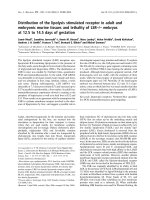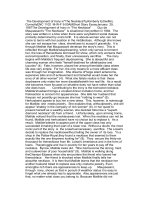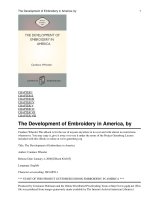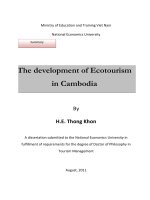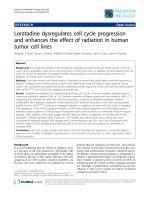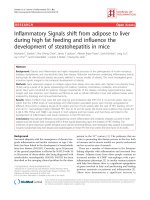Development of sphingosine kinase (SPHK) inhibitors and the role of sphingolipids in adult stem cell proliferation and differentiation 5
Bạn đang xem bản rút gọn của tài liệu. Xem và tải ngay bản đầy đủ của tài liệu tại đây (66.7 KB, 5 trang )
Chapter 5 Conclusion and Future Work
153
CHAPTER 5 CONCLUSION AND FUTURE WORK
The aim of this project was to develop new inhibitors for SPHK and investigate the
roles of SPHK and its product S1P in adult stem cell proliferation and differentiation.
Each of my result chapters contain separate conclusion sections, this chapter
summarizes all of the results presented in this thesis and discuss the potential
application and future work derived from my research project.
In the first part of the study (Chapter 2), a series of SPHK inhibitors were designed and
six of them (CP1, CP2, CP3, CP4, CP5 and CP6) were synthesized and evaluated for
further testing. I found that all of the six compounds are specific inhibitors of SPHK1,
and did not inhibit SPHK2, DAGK, or PKC alpha (the latter two enzymes were chosen
as counter-screens for compound specificity). Among the compound studied, CP3 and
CP6 showed the best inhibitory effect on the endogenous SPHK1, activated by the
signal transduction cascade, triggered by the anaphylotoxin C5a in human macrophages.
The compounds and the data generated from this part of my project form the basis for
an International Patent Application submitted in August 2007 (US Provisional Patent
Application Title: Synthesis of Sphingosine Analogues Inhibitors of Sphingosine
Kinases and Their Therapeutic Usages; Application No.: US 60/959,115).
In the second part of my project (Chapter 3), the generated SPHK inhibitor CP6 was
studied for its functions in human BM- and AD- MSCs osteogenic differentiation and
adipogenic differentiation. CP6 was selected due to its highest synthesis-yield and for
Chapter 5 Conclusion and Future Work
154
being one of the most potent and specific SPHK1 inhibitors (chapter 2), DMS was
continuously used as a reference inhibitor.
It is interesting to note that CP6 and DMS affected the osteogenic differentiation and
adipogenic differentiation in human MSCs differently. In human BM- and AD- MSCs
osteogenic differentiation, 0.5μM CP6 and DMS showed to promote the osteogenic
differentiation in most of the cases, while at higher amounts (1μM DMS and 5μM CP6)
showed to inhibit the osteogenic differentiation in most of the experiments. Interestingly,
in human BM- and AD- MSCs adipogenic differentiation, DMS and CP6 showed to
promote the adipogenic differentiation in both types of MSCs in a dose-dependent
manner. The reason for why at high concentrations CP6 and DMS inhibited the stem
cells osteogenic differentiation remains unclear.
In the future, it would be interesting to study how lower concentrations of CP6
(≤0.5μM), or any other of the compounds generated in this study, affect human MSCs
differentiation in the mixture of both osteogenic differentiation media and adipogenic
differentiation media, which may simulate a more in vivo environment. By optimizing
the concentrations of SPHK inhibitor(s) used, we could possible develop a new strategy
controlling human MSCs osteogenic and adipogenic differentiation switching.
To our knowledge, this is the first report on inhibitors of SPHK mediating human BM-
and AD- MSCs differentiation into osteogenic and adipogenic paths. Thus, the results
presented here contribute to the current understanding of human MSCs
osteogenic/adipogenic differentiation. The data described in chapter 3 might also pave
the way, for a more controlled and facilitate differentiation of stem cells, for future
Chapter 5 Conclusion and Future Work
155
therapeutic applications to balance the abnormal portions of osteoblasts and adipocytes
observed in bone diseases such as osteoporosis and osteopenia, where the bone volume
is decreased but the adipose tissue increases (Jaiswal et al., 2000). It also suggests the
potential for the use of SPHK inhibitors in preconditioning stem cells before
transplanting them into the body, by committing stem cells along specific differentiation
path. More work, including in vivo work, needs to be done to fully validate the potential
for SPHK inhibitors in adult-stem cell differentiation.
In the final part of my research project (Chapter 4), the bioactive lipid S1P was studied
for its role in promoting human BM- and AD- MSCs proliferation. The results
presented in chapter 4 show that in serum-free growth condition, S1P alone may be able
to induce only limited level of proliferation (1.2-1.3 fold growth as compared with the
serum-free media). However, S1P could work synergistically with “normal” serum
containing media (10% FBS), but more importantly, S1P showed to be able to induce an
excellent level of cell proliferation in serum-reduced media (1% FBS), especially in the
human AD-MSCs, where 1μM S1P and 1% FBS could promote around 50% more cells
growth (Figure 4.6B) when compared to the cells cultured in 1% FBS. S1P could also
work additively with PDGF-AB to promote an even higher level of cell proliferation.
Another interesting observation, described in chapter 4, is that human MSCs cultured in
S1P-supplied media managed to restore the morphology changes observed when the
cells were cultured in serum-free media. Moreover, S1P did not show to change the cell
surface markers expression profile in human BM- or AD-MSCs. Furthermore, 1μM S1P
Chapter 5 Conclusion and Future Work
156
restored the osteogenic differentiation potential lost in human AD-MSCs cultured in 1%
FBS (Figure 4.11B).
The results presented in chapter 4 suggest that S1P alone might not be potent enough
for human BM- and AD- MSCs proliferation, however, when used in combination with
serum containing media, 10% FBS or 1% FBS, or with the growth factor PDGF-AB,
S1P promoted a much better level proliferation than using serum or PDGF. Although, in
this study, S1P was not shown to be as potent in promoting adult-stem cell proliferation,
as it was shown for embryonic stem cells (Pébay et al. 2005), it is shown in this study
that S1P in combination with PDGF-AB, or reduced serum, can be an important
element in the development of better defined serum-free or serum-reduced strategies to
promote human-adult BM- and AD- MSCs proliferation. S1P is much cheaper than
most growth factors; therefore including S1P in stem cells culture media would lower
the cost of MSC proliferation. Moreover, the functions of S1P are quite well understood
compared with many growth factors. This would reduce the risk of inducing unknown
functions in MSC expansion, when using some growth factors with less known
functions.
More work need to be done to optimize a combination strategy of using S1P with other
growth factors, to promote human MSCs proliferation.
Another contribution of this study is that it provides more information on human AD-
MSCs, which is a new source of MSCs recently established (Zuk et al. 2002), with very
little studies on their expansion being reported in the literature. The benefit of using this
type of MSC is quite obvious, as the cells are extracted from “unwanted” fat. Also, the
Chapter 5 Conclusion and Future Work
157
procedure of extracting these cells is much less painful, compared with extracting
MSCs from BM. This study investigated the function of S1P, S1P+10%FBS,
S1P+1%FBS and PDGF-AB in human AD-MSCs and the results suggest a potential for
S1P in stem cell proliferation culture conditions. These findings would potentially help
speed up the research on human adipose-derived MSCs by inducing fast proliferation
with a defined serum-free or serum reduced strategy.
Finally, although this study was mainly done on tissue-specific stem cells (i.e. MSCs),
the knowledge accumulated on cell expansion and differentiation might also be
applicable in other types of stem cells. Also, it should be noticed that both human BM-
and AD- MSCs are primary cells, and thus they may possess certain variations between
different donor cells. Therefore, more work need to be done to further confirm our
conclusions. Finally, the study could be expanded to study other stem cells and other
differentiations pathways, to further validate and confirm the potential usage of SPHK
inhibitors in stem cell differentiation, and S1P roles on stem cell proliferation.

